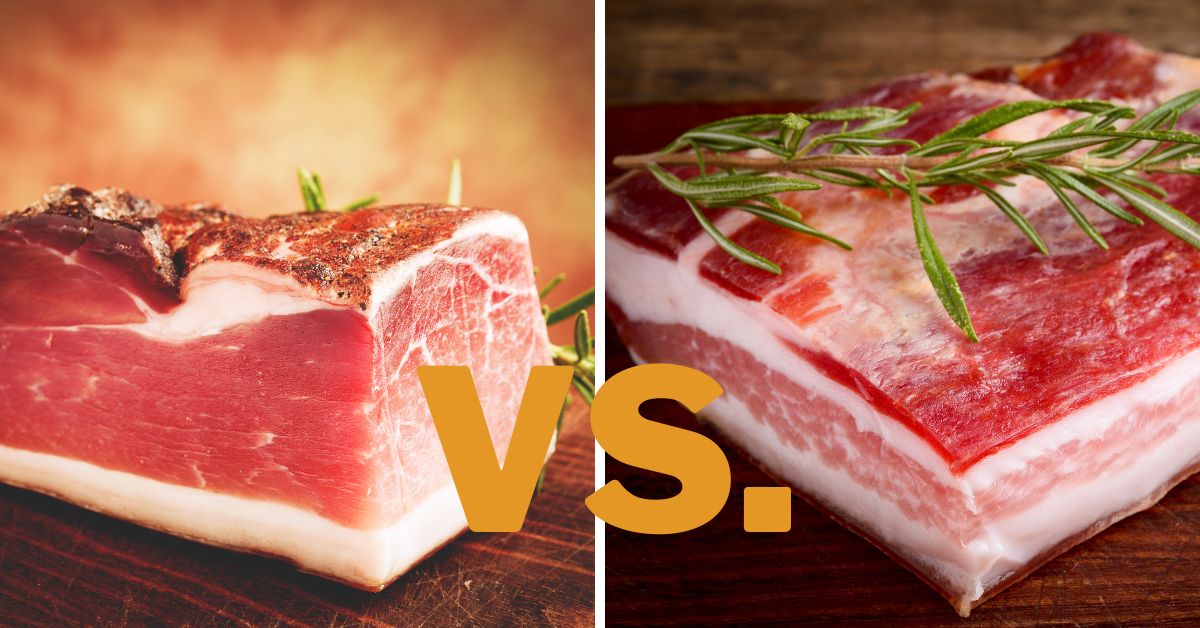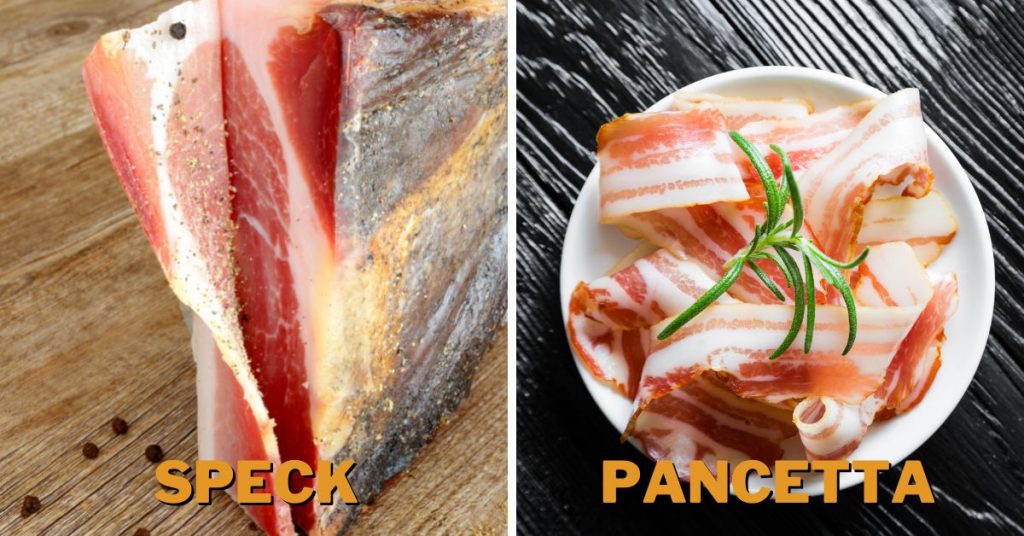Speck vs. Pancetta: Differences & Which Is Better?

Both delicious and satisfying, widely applied in many recipes, and cold appetizer combinations, speck and pancetta are perhaps the best choices to make if you want to enjoy rusticity and elegance simultaneously. Although both pancetta and speck are made of pork and, indeed, share several features in terms of taste and preparation, they are, in fact, two different types of salumi (Italian cured meat products). So, how are speck and pancetta different, and which is better?
The most significant differences between speck and pancetta are the body part they come from and the manner of preparation. While speck comes from the pig’s hind leg, pancetta comes from the belly of the pig. Speck is cured and smoked, while pancetta is only cured.
Although similar, pancetta and speck cannot be mistaken for the same product, as they are visibly different and have different tastes. While speck is often mistaken for prosciutto, pancetta is mainly mistaken for bacon. However, though they are less likely to be mistaken for the other, speck and pancetta are often mistakenly used, and that’s why I will explain the differences between these two products and give you tips on their use in the following text.
Speck vs. Pancetta: Differences
Let’s take a look at a cheat sheet before we start.
| Pancetta | Speck | |
|---|---|---|
| Origin | First recorded in the 15th century, Italy. | 15th century, Italy. |
| Preparation and ingredients | Salted and cured. It is seasoned with salt, pepper, and garlic. | Salted, cured, smoked, and cured again. Seasoned with salt and other spices. |
| Appearance and taste | Darker exterior, lighter interior with visible fat layers, spiral-shaped. Salty and fatty. | Dark on the inside and outside. Salty with smoky flavor and aroma. |
| Nutrition | Fattier than the speck. | Fatty and caloric. |
| Uses and serving | Cooked as well as cold. | Doesn’t do very well cooked and is better served as is. |
| Popularity | Popular in restaurants, but also available in the shops. | Popular in restaurants, but also available in the shops. |
Speck and pancetta are both Italian delicacies known and loved worldwide. They both have established places in many recipes where they give that special magic, but also as part of rustic and elegant cold snacks paired with dried fruit, cheese, and wine. Even though they share some similarities between them, some substantial differences define these two types of salumi as different.
Origin
Pancetta originated in Italy, though it isn’t clear exactly when. It is believed that it has a long history as the meat doesn’t undergo any other procedures besides curing and drying. However, there was no clear evidence of the period when pancetta was first made; the earliest evidence of its shipping date was from the 15th century.
Meat curing is a meat preserving technique used by the Romans, the first records of which date as early as 100 BC. It is believed that prosciutto and pancetta originated roughly around the same time since the technique is the same, whereby the source part is different.
Speck is younger than pancetta, originating in the 15th century in South Tyrol in Italy. The German-Austrian influence was strong there in that period, and the word “speck” means “bacon” in German, which many misconstrue speck as bacon.
Preparation and Ingredients
Pancetta and speck share the same base preparation technique- curing. The first step is the same for both salting and seasoning.
In order to prevent the meat from rotting due to the forming of bacteria, it needs to be heavily salted because salt sucks out all the moisture from the meat, leaving it dry and prepared for the curing period. If it’s not salted, the meat won’t even reach the curing stage as it will start decomposing in a matter of hours.
In addition to salt, another seasoning can also be added to the pancetta or speck, such as bay leaves, pepper, juniper berries, or other spices that the producer often regards as secret recipes. Since speck and pancetta production is often a family business, the families guard the seasoning blend discovering only the essential spices.
Often, the pancetta seasoning can contain garlic, and the speck seasoning frequently contains herbs.
The speck needs more time to cure. Initially, it is cured for three weeks, after which it is smoked and cured for additional 22 weeks, making the speck production process pretty time-consuming.
On the other hand, the pancetta is sliced, salted, rolled, and left to cure for three days for every 500 grams. So if the pancetta weighs 10 kilos, it will need two months to cure.
When it starts to harden, the pancetta is often placed into molds to keep its signature spiral shape. Both the pancetta and the speck are ready when they feel firm all over their surface and when the color becomes darker.
Pancetta comes from the pig belly, just like bacon, while speck comes from the pig’s hind leg, just like prosciutto.
Appearance and Taste
In terms of appearance, pancetta and speck are very different. While the speck is single-peace smoked meat you can simply slice, pancetta is spiral-looking, with the layers of fat noticeably circling through the entire piece.
The pancetta mainly has two colors on the inside: deep purple and eggshell white. The deep purple color is the meat, and the eggshell white is the layers of fat. Since it is made of the pig’s belly, pancetta contains a considerable amount of fat visible in the form of layers.
The speck has a significantly darker color than the pancetta. The speck is dark all over, with an even darker and more solid exterior and slightly less dark interior. It is smoked, which is a significant factor in the speck color, but also it is made of the pig’s hind leg, which is naturally slightly darker in color meat.
The exterior of the pancetta is also darker than the interior but still not as dark-colored compared to the speck.
In terms of the taste, both the pancetta and the speck are expressively salty. The speck also has a smoky taste and aroma due to the smoking process, whereby the pancetta can contain a slight whiff of garlic.

Nutrition
Since both are made of pork, pancetta and speck are fatty and greasy, whereby the pancetta is the fattier of the two. [1] [2] Because the speck comes from the pig’s hind leg, which is less fatty than the belly, there are no visible traces of fat, giving the speck an even appearance.
The pancetta has visible layers of fat and is considered higher in cholesterol and calories than a speck, which doesn’t make the speck lean.
In addition to the high fat and calorie content, both speck and pancetta contain decent amounts of sodium from the salt. The speck is slightly richer in protein than the pancetta because the meat is cleaner.
Although tasty and widely applicable, speck and pancetta aren’t recommended to be consumed daily, precisely because of their fattiness and high-calorie amount.
Uses and Serving
While pancetta can be used instead of bacon, meaning you can use it for everything from fried eggs, carbonara, pizza, cold or warm sandwiches, as an addition to burgers, or as is, the speck has a more restrictive use in terms of cooking.
The speck doesn’t cook well, as it is already very dry and flavorful, so its initial intention was to be used as-is, combined with other cold-served ingredients. However, culinary experimentation has shown that speck does well when slightly cooked. Therefore, adding it to a pasta sauce is an excellent choice, or top your pizza with it just a few minutes before taking it out.
Since it is less fatty than the pancetta, the speck doesn’t melt or shrink when cooked, and all you get is just a hardened slice of a speck that isn’t too pleasant nor easily palatable.
Therefore, if you want to cook, use the pancetta, and if you want a cold meaty snack, use the speck. If you decide to experiment, do so with caution.
Popularity
Pancetta and speck are very popular in Europe, mainly in Italy, which doesn’t mean that they are anonymous in the rest of the world. Since they are both made of pork, they aren’t too popular in the Middle East, but they have their beef counterparts.
You can find pancetta and speck in many restaurants worldwide, but they are also available in the stores. Some shops specializing in cured meats carry top-quality pancetta and speck, but you can get them in the regular local store.
Speck vs. Pancetta: Which Is Better?
Both have qualities with much to offer; to say that one is better is rude to the other. I’d say that it is a matter of preference, what you want at a specific time.
If you want to cook a sauce or fry some eggs with some bacon on the side, or you are craving a greasy pizza, I’d recommend you go for the pancetta.
Go for the speck if you are in the mood for wine and romance.
Is Speck the Same as Bacon?
The word “speck” means bacon, but speck isn’t bacon. Bacon is made from the pig’s hind leg, whereas bacon is made from the pig’s belly. The speck is obligatorily smoked because if it isn’t, then it wouldn’t be a speck, while bacon is, by definition, not smoked.
Can You Use Speck Instead of Pancetta?
Speck and pancetta aren’t exactly interchangeable. If you want to substitute speck for pancetta as a cold snack, that’s fine, but if you want to cook the pancetta and cook the speck the same way, that won’t give you the desired result.
Can You Use Pancetta Instead of Speck?
Pancetta can substitute for speck more than vice versa. For example, you can make perfect carbonara using pancetta, while speck carbonara isn’t such a good idea. The pancetta can be served as-is and cooked, as it does well under increased temperatures.
